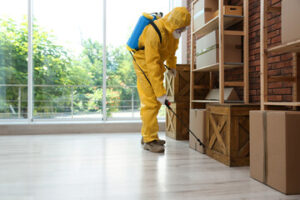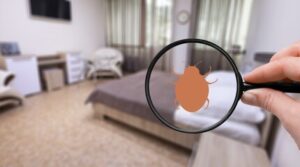Pests like cockroaches, flies, and mice can contaminate food and pose health risks to patrons. They also violate food safety regulations and reflect poorly on a restaurant.
Maintaining meticulous cleanliness throughout the interior of a restaurant is essential to keeping pests at bay. Dining areas should be wiped down after each guest leaves and storage spaces should be clean, including pantries and walk-in coolers. Springfield MO Pest Control experts should be called right away.

Keep Your Food Fresh
In the restaurant business, one pest infestation can cause a major disaster. It can ruin a company’s reputation with customers who refuse to visit an eatery where buzzing flies and rodent droppings are a constant reminder. Pests can also create health risks for staff and pose a threat to food safety. The best way to prevent a restaurant from getting pests in the first place is to practice consistent, hygienic cleaning and preventative maintenance.
Routine cleaning and sanitization should be non-negotiable. This should include thorough cleaning of all areas, especially kitchens, dining spaces, and storage areas. This should be followed by careful inspections for pest entry points, which can often be small cracks or gaps around pipes, electrical conduits, or venting. Tight-fitting screens and caulk are essential to stopping pests from entering a restaurant. It is also important to inspect the exterior regularly, looking for places where pests could sneak in from outside.
Regular trash removal and a good system for handling food waste are important as well. Using plastic liners in indoor trash bins and taking out outdoor dumpsters as soon as they are full will help deter pests. Water sources should be regularly checked as well, and all leaks and excess moisture must be addressed immediately.
Staff should be encouraged to participate in ongoing training on hygiene and pest prevention. This can include hands-on workshops that demonstrate the proper methods for sanitizing equipment, storing foods properly, and conducting regular cleanliness checks. Having all employees on board with these practices will significantly decrease the chances of pest infestation in restaurants, and it will help prevent food contamination that could lead to a customer boycott.
If a pest infestation does occur, a professional pest control service can come in and treat the property. This can include the use of traps, baits, and other humane pest control solutions that don’t expose staff or customers to chemicals. After treatment, a pest control company will often recommend additional preventative measures like sealing off entry points and suggesting specific cleaning routines.
The most common types of restaurant pests are rodents, cockroaches, and flies. Rodents can contaminate food with their droppings and urine, posing a serious health risk. Cockroaches spread bacteria through their bodies, which can contaminate surfaces and food, and flies transmit germs from unsanitary areas to uncovered foods. In addition, stored product pests, such as weevils, moths, and beetles can infest dry goods, causing them to spoil and posing a health risk for consumers.
Seal Off Entry Points
Pests invade restaurants to feed on food and nest, carrying disease-causing pathogens that can make customers sick. In addition to harming the health of patrons, a pest infestation can damage a business’s reputation, leading to negative reviews and unpalatable word-of-mouth, loss of customer loyalty, and a downturn in revenue. Preventing pests in restaurants requires a combination of regular inspections, preventive measures, staff training, and the support of expert pest control professionals.
To keep pests out of restaurants, seal off entry points into buildings and close up any gaps that are large enough to fit a mouse. Mice can slip through holes the size of a pencil, so it is important to regularly inspect and close up cracks in walls and around utility penetrations.
Food storage areas can also be protected by installing airtight containers and storing food items on high shelves. By implementing a food rotation schedule and keeping trash bins clean, restaurants can discourage pests and increase food safety.
Establishments that offer outdoor dining or seating should regularly inspect these areas for pests, ensuring they are free of spoiled or rotting foodstuffs and food scraps. These areas can also be made less attractive to pests by trimming back shrubbery and trees near the restaurant, removing any piles of leaves or debris, and changing out fluorescent lighting for sodium vapor lights that are more deterrent to night-flying insects.
Lastly, restaurants should encourage staff members to be vigilant about early indications of pest activity. By recognizing the signs of pests, such as droppings, gnaw marks, and unusual odors, restaurant workers can act swiftly to prevent full-blown infestations.
A well-trained staff is your strongest defense against the risk of pests in restaurants. Regular staff training sessions on pest identification, as well as the symptoms of their presence, empower your team to identify and respond to these signs promptly and effectively. In turn, this allows them to engage pest control services immediately, limiting the impact of an outbreak and its associated risks. Incorporate a checklist for monitoring pests into your daily cleaning routines, assigning each task to a specific member of the crew.
Keep Your Restaurant Clean
The best way to prevent pests in restaurants is to keep the restaurant clean. This includes storing food in sealed containers, properly cleaning up spills, and emptying trash regularly. It also means keeping all equipment and utensils clean after each use and disposing of waste promptly. It’s also important to avoid allowing water sources to collect in and around the restaurant. This could include clogged sinks, leaking pipes, or even just standing water on the floor.
Rodents are one of the most common pests in restaurants. Droppings from rodents can contaminate food and make customers sick, while their urine can damage surfaces and create a foul odor. Rodents are also known to spread disease through their bites. Flies are another serious problem in restaurants. They can transfer pathogens from their feet to food and surfaces, and they are attracted to decaying waste.
Keeping the exterior of your restaurant clean is also important. Trimming back trees and shrubs, sealing cracks, and installing air curtains can all help to deter pests from entering the restaurant. Lastly, make sure that all windows and doors are closed when not in use, and that screens are in good shape.
It’s a good idea to hire a professional pest control company to perform regular inspections of your restaurant. An experienced pest control technician will be able to identify potential entry points and treat them before a pest infestation becomes a major issue. Look for a company with an integrated pest management (IPM) program. IPM minimizes the use of pesticides by focusing on prevention rather than just treating an infestation. A good IPM program will include regular inspections, targeted treatments, and ongoing monitoring to prevent future pest problems. It will also help educate your staff on how to prevent pests in the restaurant and provide training on how to identify pest activity. Employees are usually the last line of defense against pests in restaurants, so they must understand how their actions can affect the restaurant’s reputation and safety. They should also be trained on how to properly implement pest-deterring cleaning practices.
Hire A Pest Control Company
If pests have invaded your restaurant, a professional exterminator should be called in to assess the situation and find a solution. The right company can help you save money, keep your customers happy, and maintain food safety standards. Look for a pest control company that is licensed, insured, and has tenure in the industry. They should provide you with a detailed, site-specific assessment of your restaurant to identify pests and their entry points and harborage areas. Then they will implement a treatment plan. This may include traps, baits, and/or chemical treatments. Look for a company that uses low-toxicity pesticides specifically formulated for use in restaurants and other food service establishments. Ensure that your pest control technician understands the unique needs of your business, such as the requirement to store and dispose of food in sealed containers.
Rodents, cockroaches, fruit flies, and other insects can infest restaurants, contaminating the food supply with their droppings and bacteria. They also pose health risks to employees and customers. A contaminated food source can cause serious illness, especially in vulnerable people like children and the elderly. Having pests in your restaurant can also negatively affect your reputation. Many consumers have a low tolerance for seeing rodents or bugs in restaurants and are unlikely to return, even if the food is good.
The best way to prevent pests in your restaurant is to make sure the food is prepared in a dedicated area only, keeping it separate from the seating and dining areas. Regular deep cleaning and sanitizing are also necessary. This includes sanitizing surfaces that are likely to attract pests, such as tables and seats. Trash bins should be emptied regularly to avoid overflowing and to minimize the presence of rotting or spoiled foods that are attractive to pests.
In addition, it is important to close off entry points to your building and check outside areas for cracks or holes that could allow pests to enter. Exterior doors should be kept closed, and loading dock areas should be inspected frequently to prevent pests from hitching rides on incoming deliveries. Also, windows should be screened and capped to limit the number of pests that can get inside.


